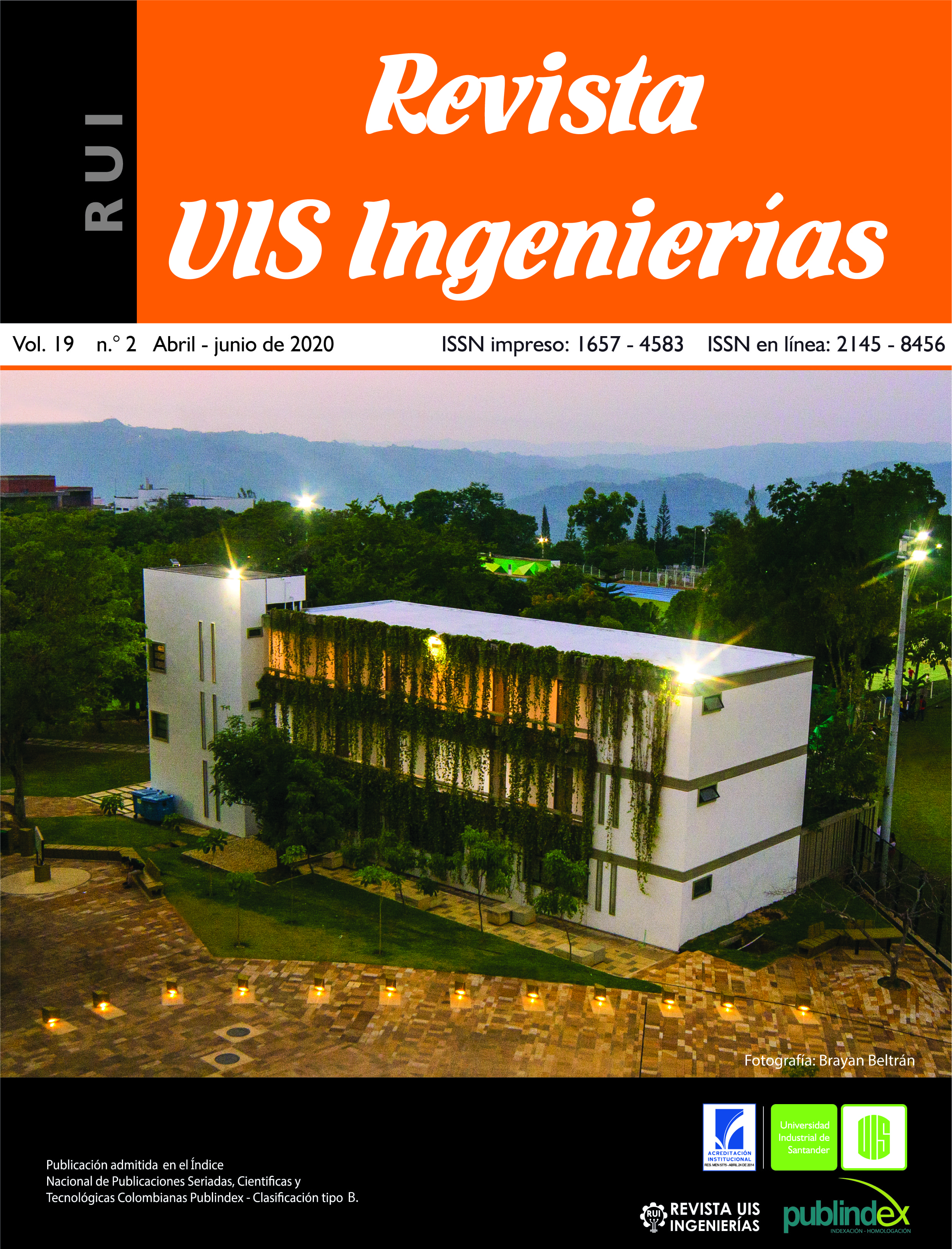Development of a rainwater harvesting model for broiler farms
Published 2020-03-24
Keywords
- mathematical model,
- poultry production,
- agricultural production,
- weather station,
- rainwater
How to Cite
Copyright (c) 2020 Revista UIS Ingenierías

This work is licensed under a Creative Commons Attribution-NoDerivatives 4.0 International License.
Abstract
The access to water is critical in agricultural and livestock production. In the dry season, the water supply systems are under stress and have placed the region of La Mesa de Los Santos (Santander-Colombia) as susceptible to economic impacts due to water shortages, mainly caused by high demand in growth population, agriculture and the poultry production. Currently, the poultry production suffers from water shortages and has been supplied with liquid in tanker trucks during the dry season, presenting a significant added cost to the farmers. The implementation of a rainwater-harvesting (RWH) system could reduce the water stress on the poultry industrial production of the region. The main objective of this research was to develop a mathematical model to identify the numbers of poultry grown cycles that a rainwater harvesting (RWH) system could potentially feed in an average year of precipitations. The analyses performed here considered daily rainfall data ranged from 2010 to 2018 obtained from the weather stations in La Mesa de Los Santos. The results of this research can be helpful to the entrepreneurs and policymakers by evaluating the importance of water management and the opportunity to take advantage of rainwater as a resource for sustainable poultry production, currently an important alternative to the value chain in the agricultural, livestock and industrial sector of the region.
Downloads
References
[2] FAO, Earthscan, “The State of the World’s land and water resources for Food and Agriculture. Managing systems at risk,” The Food and Agriculture Organization of the United Nations and Earthscan, 2011. [Online]. Available: http://www.fao.org/3/a-i1688e.pdf
[3] FAO, “Feasibility study of rainwater harvesting for agriculture in the Caribbean subregion,” The Food and Agriculture Organization of the United Nations, 2014. [Online]. Available: http://www.fao.org/3/a-bq747e.pdf
[4] FAO, “Review of World Water Resources by Country: 2. Concepts and Definitions,” The Food and Agriculture Organization of the United Nations, 2003. [Online]. Available: http://www.fao.org/tempref/agl/AGLW/ESPIM/CD-ROM/documents/5C_e.pdf
[5] WAVES, “Water Potential and Challenges Discussed at Colombia Forum,” Wealth Accounting and the Valuation of Ecosystem Services, 2015. [Online]. Available: https://www.wavespartnership.org/en/water-potential-and-challenges-discussed-colombia-forum
[6] IDEAM, “Reporte de avance del estudio nacional del agua,” Instituto de Hidrología, Meteorología y Estudios Ambientales, IDEAM, 2018. [Online]. Available: http://www.ideam.gov.co/documents/24277/76321271/Cartilla+ENA+2018+WEB+actualizada.pdf/ba353c39-b15d-4a76-8ed4-3814c4c35239
[7] J. T. Hernandez-Estrada, “Habitantes de la Mesa de los Santos se quejan por aumento de granjas avícolas,” Periódico 15, 2017. [Online]. Available: https://www.periodico15.com/habitantes-de-la-mesa-de-los-santos-se-quejan-por-aumento-de-granjas-avicolas/
[8] L. A. Cardenas-Mateus, “Tres años después Los Santos , Santander , permanece sin agua potable,” EL Tiempo, 2019. [Online]. Available: https://www.eltiempo.com/colombia/otras-ciudades/el-municipio-los-santos-santander-sigue-sin-agua-370856
[9] Alcaldía Municipal de Los Santos, “Esquema de Ordenamiento Territorial de Los Santos,” 2003. [Online]. Available: http://lossantos-santander.gov.co/Transparencia/BancoDocumentos/Documento%20Diagnostico%20-%20Componente%20Pol%C3%ADtico%20Adm%C3%B3n%20y%20Financiero,%20Municipio%20de%20Los%20Santos.pdf
[10] DANE, 3er Censo Nacional Agropecuario, vol. 2. 2016.
[11] DANE, “Censo Avicola Industrial, Revista Avicultores, Veterinaria,” Revista Fenavi, 2002. [Online]. Available: http://encolombia.com/veterinaria/publi/fenavi/f93/fenavi9303actualidad/
[12] M. R. Velásquez, “Industria avícola en Santander en riesgo por fenómeno de El Niño,” El Espectador, 2014. [Online]. Available: https://www.elespectador.com/noticias/nacional/industria-avicola-santander-riesgo-fenomeno-de-el-nino-articulo-506277
[13] IDEAM, “Catalogo Estaciones IDEAM | Datos Abiertos Colombia,” MinTic, 2019. [Online]. Available: https://www.datos.gov.co/Ambiente-y-Desarrollo-Sostenible/Catalogo-Estaciones-IDEAM/n6vw-vkfe
[14] Organización de Aviación Civil Internacional, “Registro de históricos METAR en la estación meteorológica Bucaramanga / Palonegro,” ElTiempo.net, 2019. [Online]. Available: https://www.tutiempo.net/registros/skbg?_ga=2.76957712.464411645.1583411889-233359838.1583411889
[15] C. Euscátegui and H. Gonzalo, “Análisis del impacto del fenómeno ‘La Niña’ 2010-2011 en la hidroclimatología del país,” IDEAM, 2010. [Online]. Available: http://www.ideam.gov.co/documents/21021/418818/An%C3%A1lisis+Impacto+La+Ni%C3%B1a.pdf/640a4a18-4a2a-4a25-b7d5-b3768e0a768a
[16] J. E. Montealegre-Bocanegra, “Actualización del componente Meteorológico del modelo institucional del IDEAM sobre el efecto climático de los fenómenos El Niño y La Niña en Colombia, como insumo para el Atlas Climatológico.,” IDEAM, 2014. [Online]. Available: http://www.ideam.gov.co/documents/21021/440517/Actualizacion+Modelo+Institucional+El+Ni%C3%B1o+-+La+Ni%C3%B1a.pdf/02f5e53b-0349-41f1-87e0-5513286d1d1d
[17] G. León-Aristizábal, “Aspectos de la circulación atmosférica de gran escala sobre el noroccidente de Suramérica asociada al ciclo enos 2009-2010 y sus consecuencias en el régimen de precipitación en Colombia,” IDEAM, 2011. [Online]. Available: http://www.ideam.gov.co/documents/21021/418818/Circulaci%C3%B3n+Atmosf%C3%A9rica+ENOS++2009-2010_GloriaLeon.pdf
[18] IDEAM, “Impacto del Fenomeno El NIÑO 2015- 2016,” IDEAM, 2016. [Online]. Available: http://www.ideam.gov.co/documents/11769/132669/Impacto+de+El+Ni%C3%B1o+en+la+alta+monta%C3%B1a+colombiana.pdf/dd41d158-0944-41d5-917e-44fdb524e8ea
[19] Fenavi, Fonav, “Código Buenas Prácticas Avícolas - BPAV,” 2011. [Online]. Available: https://fenavi.org/wp-content/uploads/2019/02/C%C3%93DIGO-BUENAS-PR%C3%81CTICAS-AV%C3%8DCOLAS-BPAV-V2.pdf
[20] FINAGRO, “AVICULTURA - Marco de referencia agroeconómico,” 2017. [Online]. Available: https://www.finagro.com.co/sites/default/files/node/basic-page/files/avicultura_de_engorde.pdf
[21] Cobb-vantress, “Guía de Manejo del Pollo de Engorde pollo de engorde COBB Guía de Manejo del Pollo de Engorde IntrOduCCIOn,” 2012. [Online]. Available: http://www.pronavicola.com/contenido/manuales/Cobb.pdf
[22] DANE, “El Pollo de engorde (Gallus domesticus),” Departamento Administrativo Nacional de Estadística (DANE), 2015. [Online]. Available: https://www.dane.gov.co/files/investigaciones/agropecuario/sipsa/Bol_Insumos_jun_2015.pdf
[23] R. Farreny, T. Morales-Pinzón, A. Guisasola, C. Tayà, J. Rieradevall, X. Gabarrell, “Roof selection for rainwater harvesting: Quantity and quality assessments in Spain,” Water Res., vol. 45, no. 10, pp. 3245–3254, 2011. doi: 10.1016/j.watres.2011.03.036
[24] A. Khastagir, N. Jayasuriya, “Parameters Influencing the Selection of an Optimal Rainwater Tank Size : A Case Study for Melbourne,” Proc. Rain Water Urban Des. Conf., no. September, pp. 21–23, 2007.
[25] L. Manning, S. A. Chadd, R. N. Baines, “Water consumption in broiler chicken: a welfare indicator,” Worlds. Poult. Sci. J., vol. 63, no. 1, pp. 63–71, 2007. doi: 10.1017/S0043933907001274
[26] Solla, “Manual de manejo para pollo de engorde,” 2015. [Online]. Available: https://www.solla.com/sites/default/files/productos/secciones/adjuntos/Manual%20De%20Manejo%20Para%20Pollo%20De%20Engorde.pdf
[27] S. Gottlieb, “On high order strong stability preserving Runge-Kutta and multi step time discretizations,” J. Sci. Comput., vol. 25, no. 1, pp. 105–128, 2005. doi: 10.1007/BF02728985

